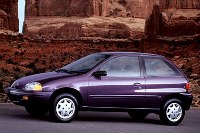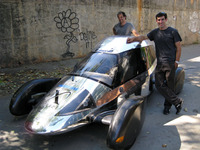
In the late ’80s and into the mid-90’s Americans had the opportunity to buy automobiles that were quite fuel efficient. On one gallon of gas the Geo Metro, a small-bubble like car, could travel 53 to 58 miles.* In 1984, one could purchase a Chevy Sprint, another strikingly compact model, that could get 44 to 53 miles per gallon.** Today, when one watches television on a major network, one is likely to see advertisements peddling the latest fuel efficient car. One may see ads for a Volkswagen Jetta that gets 30 to 41 mpg, a Mini Cooper that gets 25 to 33 mpg, a Honda Accord that gets 22 to 31 mpg, a Hyundai Sonata that gets 22 to 32 mpg, the Hyundai Elantra that gets 26-35 mpg, or a Chevy Aveo that gets up to 35 mpg.*** It is common for such advertisements to attempt to evoke amazement in the viewer on account of the astounding accomplishment of contemporary automobile fuel efficiency. Yet, for those who remember the auto advertisements of yesteryear, these contemporary ads hint at a deficiency in cultural memory.

Earlier this month, three teams of innovative engineers were awarded $10 million (to spilt) in prize money for designing a supremely fuel efficient vehicle that may also appeal to leaders of the automobile industry. The competition, called the “X Prize,” is sponsored by Progressive Insurance and aims to promote innovation. Peter Diamandis, the CEO of the X Prize Foundation, went on record saying, “This is a prize to show the public that you can have a car that is beautiful, affordable, fast, safe and, Oh by the way – it can get over 100 mpg or the gas equivalent. And why would you want anything else?”
The winning vehicle, named the “Very Light Car,” was built by the Edison2 design team who is based in Lynchburg, VA, and is headed by Oliver Kuttner. The specifications for this gas powered car revolve around simplicity and lightness. The Very Light Car seats four, gets over 100 mpg, and weighs only 840 pounds. Describing the Very Light Car, Kuttner states, “It has a heater. It has some basic ventilation. It accelerates briskly enough not to hold up traffic. But it’s just a modest car.” As for the team’s design philosophy, they seek to use “recyclable and low-cost materials.” And, echoing this philosophy, Kuttner states, “If we as a society want to use less energy, we must design cars that can be sold for, let’s say, $20,000 and deliver this unprecedented level of efficiency.”
Clearly, it is an achievement to engineer an automobile that is capable of traveling over 100 miles on one gallon of gas. This is even more striking when compared to the gas mileage of the cars currently on the market. Yet, it is less striking when compared to the cars on the market in the 1980’s that were capable of 50 plus miles per gallon. Nonetheless, the Edison2 team and their Very Light Car deserve praise for their achievement.
So, how does the X Prize relate to being a Liberal Evangelical? The amazement that the engineers’ achievements evoked in the popular imagination reveals the potentially ephemeral nature of cultural memory. And, why does this disclosure matter to Liberal Evangelical circles? This disclosure is significant because it draws attention to one of the strengths of the Liberal Evangelical tradition. Faith traditions are “traditions” on account of their ability to transmit events of the past to future generations. Liberal Evangelicals have a keen interest in retaining memory of important events, accomplishments, and insights of the past and sharing and teaching them to posterity. Furthermore, these communities have institutionalized practices that facilitate such retention and transmission. This concern and capacity makes communities of faith superb models of memory transmission for popular culture. In addition, communities of faith can help prompt popular culture to remember significant events, accomplishments, and insights of past generations when such has been overlooked or forgotten.
Links
*To see information about the Geo Metro click here.
**To see information about the Chevy Sprint click here.
***To see information about these automobiles click here.
To read “X Prize Marks Fuel-Efficiency Spot For Future Cars” by Joshua Brockman click here.

